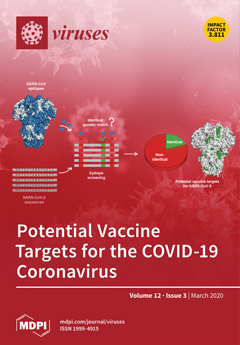Bovine leukemia virus (BLV) is the causative agent of enzootic bovine leucosis. However, less than 5% of BLV-infected cattle will develop lymphoma, suggesting that, in addition to viral infection, host genetic polymorphisms might play a role in disease susceptibility. Bovine leukocyte antigen (BoLA)
[...] Read more.
Bovine leukemia virus (BLV) is the causative agent of enzootic bovine leucosis. However, less than 5% of BLV-infected cattle will develop lymphoma, suggesting that, in addition to viral infection, host genetic polymorphisms might play a role in disease susceptibility. Bovine leukocyte antigen (BoLA)
-DRB3 is a highly polymorphic gene associated with BLV proviral load (PVL) susceptibility. Due to the fact that PVL is positively associated with disease progression, it is believed that controlling PVL can prevent lymphoma development. Thus, many studies have focused on the relationship between PVL and
BoLA-DRB3. Despite this, there is little information regarding the relationship between lymphoma and
BoLA-DRB3. Furthermore, whether or not PVL-associated
BoLA-DRB3 is linked to lymphoma-associated
BoLA-DRB3 has not been clarified. Here, we investigated whether or not lymphoma-associated
BoLA-DRB3 is correlated with PVL-associated
BoLA-DRB3. We demonstrate that two
BoLA-DRB3 alleles were specifically associated with lymphoma resistance (
*010:01 and
*011:01), but no lymphoma-specific susceptibility alleles were found; furthermore, two other alleles,
*002:01 and
*012:01, were associated with PVL resistance and susceptibility, respectively. In contrast, lymphoma and PVL shared two resistance-associated (
DRB3*014:01:01 and *
009:02)
BoLA-DRB3 alleles. Interestingly, we found that PVL associated alleles, but not lymphoma associated alleles, are related with the anti-BLV gp51 antibody production level in cows. Overall, our study is the first to demonstrate that the
BoLA-DRB3 polymorphism confers differential susceptibility to BLV-induced lymphoma and PVL.
Full article






